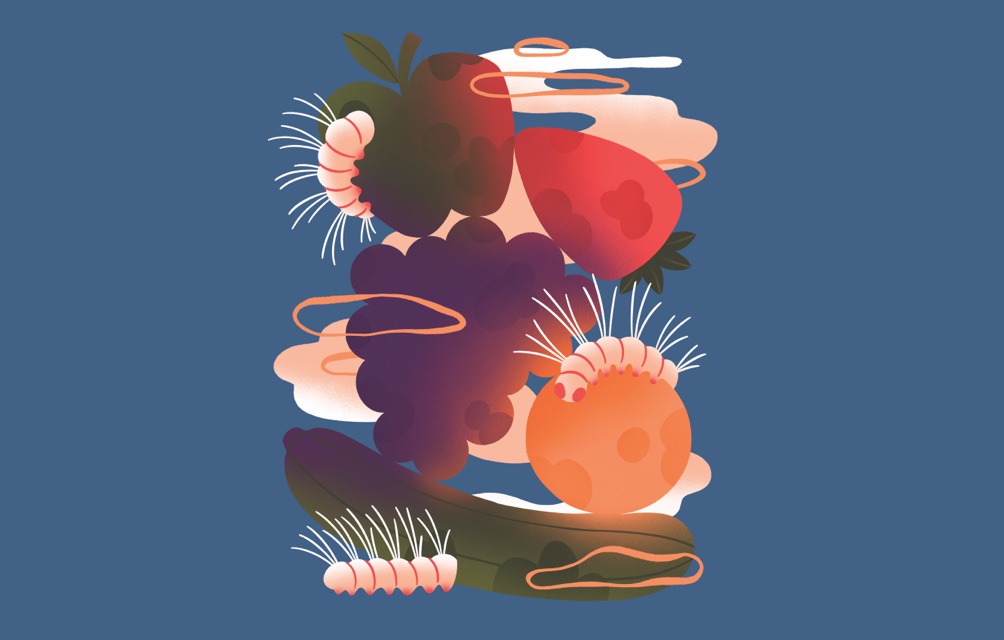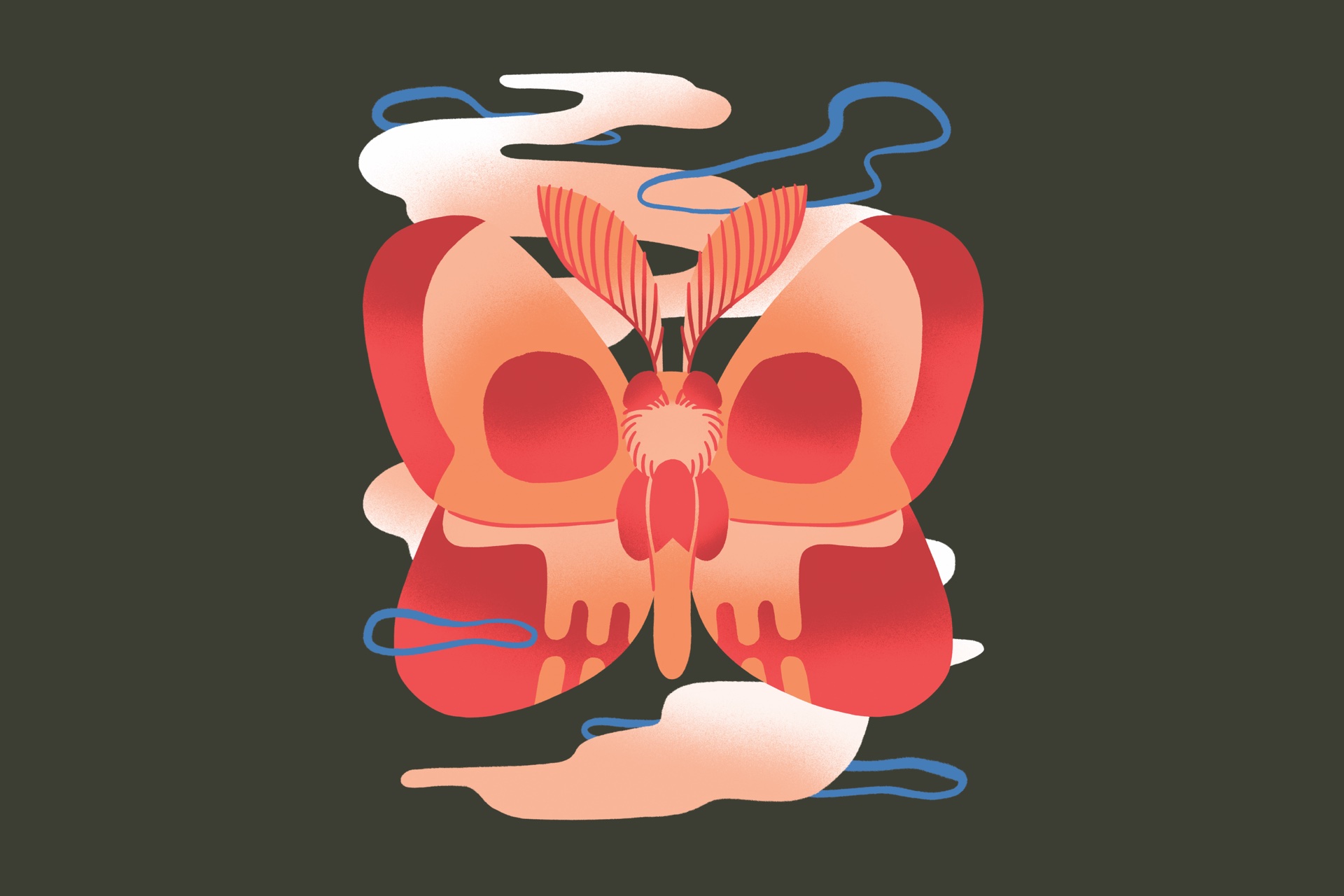Jul 15, 2024 Society
One morning in May 1999, Jane Sumich noticed an infestation of caterpillars on her kitchen wall in Glendene and rang the Waitakere City Council in a panic. What were these things? And where had they come from?
The call was connected to me at the mayoral office. I was no expert in crawling insects but I knew someone who was — councillor Peter Maddison. He had spent a lifetime at the old Department of Scientific and Industrial Research in Mt Albert and was considered a world expert on moths, butterflies and anything that crept or crawled. I rang Maddison and asked him whether Sumich’s caterpillars were worth the panic. There was muted silence for a few moments and then he said he would take a look. In the next two hours, he raced over to check the infestation, then sounded the alarm. West Auckland was being invaded! Our new enemy: the dreaded Australian painted apple moth.
Maddison’s urgent call to the Ministry of Agriculture and Forestry (MAF) started a chain of events that resulted in New Zealand’s fifth-largest city being bombed from the air with what to the public was an unknown and top-secret cocktail of dusty poison. The next few months would create hell. If done today, there would be vigorous protests and it would make world headlines. As mayor, I was proud to have established (with Maddison’s help) Waitākere as an Eco City, so it was gut-wrenching when I finally realised what the government was about to unleash on our residents, all because of a few caterpillars.
But these caterpillars, and the moths they would become, were a huge threat. Not only to our local orchards, market gardens and vineyards — the West was considered the ‘fruit bowl of Auckland’ — but if the painted apple moth spread throughout the entire country’s forestry and horticultural industries, MAF claimed, it could create an environmental and economic catastrophe, costing the nation anything from $48 million to $350 million over 20 years. There were also concerns that the moth could invade the Waitākere Ranges and harm its unique native flora and fauna.
MAF began surveying the problem, placing traps and doing ground-spraying, removing and burning affected trees. It called this “a conservative and responsible approach”, and the project leader, MAF’s director of forest biosecurity Dr Ruth Frampton, said in January 2000 that she was “cautiously optimistic” the pest had been wiped out.
But by late 2001, the pesky moth remained. Drastic measures were required. The battle plan was so sensitive and important that it went up to the Cabinet for approval — we would spray from the air. To this day, we still have no idea of what exactly was in the spray, known as Foray 48B, which from early 2002 found its way into our homes, businesses, gardens, waterways and presumably our bodies. Its chemical make-up was a trade secret, jealously guarded by the company which makes it, and shared only with MAF, the Ministry of Health and a few other agencies and regulators. But it was tough stuff — even the asthmatic chimps at Auckland Zoo in Western Springs were brought indoors out of harm’s way.
The bombing of West Auckland is still strong in every Westie’s memory. And not in a post-Covid, anti-vaccine, anti-establishment conspiracy-theorist way — this actually happened to hundreds of thousands of people. The planes started flying overhead, dropping chemicals on our city, but none of us — other than those select few officials and the multinational manufacturers — knew what it contained. Even the information we were given was hard for the average person to understand. The active ingredient was an organic insecticide called Btk — Bacillus thuringiensis, subspecies kurstarki — a group of bacteria that occur naturally in soil, water and air in countries including New Zealand. Btk works by attacking the gut of caterpillars, but doesn’t affect other organisms, and it had been used in New Zealand by organic growers since 1984. But was there more than Btk in the spray? Yes — non-active chemicals that were apparently also used in some foods, cosmetics and pharmaceuticals and seemed to provoke allergic reactions in some people. When asked for the full list of components, MAF would say only: “This information is commercially sensitive.”
Essentially, helicopters and fixed-wing planes ‘crop-dusted’ a whole region, sometimes several times a week. The poison fell on 33 days between October 2002 and May 2003. Up to 165,000 people (equivalent to the population of Hamilton) were showered with each pass. Schools hustled children inside; tradies huddled under the eaves of half-finished houses. Doors and windows slamming shut echoed around neighbourhoods. If you were in a car, you turned your air con off and your wipers on. While the tiny painted apple moth was the target, thousands of people also got a regular dose.
Within days of the first drop, there were numerous reports of health issues — runny eyes and noses, rashes, diarrhoea. Within weeks, environmental Westies started to form protest groups, demanding the council and the Ministry of Health reveal the full contents of the spray. There were protest marches through Henderson and New Lynn. The council asked the ministry to come to a full council meeting and explain just how long New Zealand’s greenest city would suffer the indignity of weekly spraying.
As mayor, I asked again that officials from MAF and the Ministry of Health tell us what we were being forced to breathe and ingest. The response was stonewalling and repetition of that “commercial sensitivity” line. The questions became more demanding. Again, nothing. The two relevant ministries refused to provide any sort of detail about the chemical make-up — presumably they’d signed a contract with the manufacturer binding them to secrecy. Not exactly reassuring. And in the absence of firm information, rumour and gossip spread. The community widely believed that the spray was produced by the American giant Monsanto, one of the largest corporations in the world. Mutterings were heard about the spray’s similarity to anthrax.
The reassurance we did get was contradictory. A MAF press release in November 2001 explained that the spray did not harm animals, fish or humans, full stop. It noted “no adverse health effects” from a previous use of Btk to eradicate the white-spotted tussock moth. Yet “minor respiratory irritations” could be expected from the spray, and residents, especially those with allergies or other sensitivities, were advised to take the precaution of staying inside: “If you are in the spray zone it would be wise to close your windows and stay inside while the spraying is taking place.”
Health organisations had taken something of a back seat during all of this — seeming to defer to the science coming out of MAF. The Ministry of Health let MAF lead, playing a consultative role. And while the Auckland District Health Board signed off on the aerial spraying programme, asserting that the spraying would “not be hazardous to the health of residents”, it also warned that “people might suffer from minor skin, eye or upper respiratory tract [issues] if they were directly exposed to the spray or substantial spray deposits”.
It was time for me to get some help from above, so I called Jim Anderton, who at the time was the Minister of Biosecurity. I told him that, as mayor, I couldn’t take a government edict to spray the city without knowing the ingredients of the spray. Anderton, whom I’d worked with on rebuilding the Labour Party during the Muldoon era and considered a friend, pulled out the big government guns. He told me in no uncertain terms that if I bucked the government’s direction on this issue I could be charged with sedition, a crime carrying a maximum prison term of 2 years.
Responding in 2007 to a critical report from the Ombudsman, Anderton completely downplayed the health effects of the spray. “A small number of people were mildly affected by the spraying. A number of those were relocated during the spraying; received any necessary medical attention; and were monitored”. In a lengthy, defensive press release, Anderton claimed that the government had wanted to disclose the full list of ingredients but had been “blocked” by the spray manufacturer. Then the minister made an extraordinary admission, saying straight out that “release of product ingredients would jeopardise New Zealand’s access to this and other pest management products in the future”. To protect our ability to shop for future poisons, the government seems to have signed away New Zealanders’ rights to informed consent about a community-wide ecosystem shock treatment.

Remembering these days of hell, I went to see Peter Maddison, now retired. As both a scientist and a councillor at the time, Maddison remembers the goings-on clearly. He cared deeply about how the community felt and reacted. Maddison told me that the first calibration flight for the spraying was interesting — what was sprayed was pure water, nothing more than rain. This first run was by helicopter over Span Farm in Glendene, Waikumete Cemetery and some orchards in Oratia, but the nozzles either jammed or did not spray effectively. Using a fixed-wing aircraft instead was the next option.
Maddison had advocated for clear notices about flight times so that people could be prepared and those concerned about their own health or that of their pets could take shelter. Advance communication was complicated by changeable weather — the planes needed good weather to fly and at least five hours of dry weather afterward for the spray to work. After some argument, a provision was set up for severely immunocompromised people to be taken out of the spray zone for a few hours. There were nearly 80 complaints after the first round of spraying and the council decided it would move people to motels if there were severe respiratory problems.
I asked Maddison about the effects of the spray on insects. Given that Btk attacks caterpillars of all varieties, MAF had noted beforehand that “non-targeted moth and butterfly species could be affected” but “are expected to recolonise fairly quickly from outside the area”. Many of us in zone saw that up close: the spray killed not only the painted apple moth but also monarchs and white butterflies. This had a huge impact on the diversity of insects in Waitākere City, and must have had significant knock-on effects for the bird life and other natural life cycles in trees, meadows and grassy areas, including parks. MAF had guesstimated three years for a full caterpillar recovery, which Maddison felt was about right. I felt like it took a decade.
In 2005, these and other questions were taken up by the ‘People’s Inquiry’. This was coordinated by a range of individuals and organisations with names such as WASP (West Aucklanders Against Aerial Spraying), SAS (Stop Aerial Spraying), TASK (Teachers Against Spraying Kids) and GASP (Group Against Spraying People). We at Waitakere City Council were not officially involved but showed support by providing our council chambers for five days of hearings, at which evidence was heard by four commissioners — social scientist Dr Joanna Goven, bioethicist Dr Tom Kerns, toxicologist Professor Romeo Quijano and kaumātua and indigenous rights activist Del Wihongi.
The inquiry (and the groups and people behind it), which had a clear agenda, failed to galvanise public support. With a budget of just $20,000, it resulted in little more than 160 submissions, and many considered both the evidence presented and the findings one-sided. But the People’s Inquiry made 27 recommendations. Minister Anderton rejected them wholesale and none have been implemented by any government agency.
More credible is a 2005 report prepared by the Institute of Environmental Science and Research (ESR) for the Ministry of Health, which found “statistically significant” differences in hospitalisation rates for respiratory diseases during the spray programme. But, again, no direct causal link could be established. As with so many of the studies and reports on painted apple moth, there were a lot of numbers, theories and possibilities. But no hard conclusions were drawn. Nothing to see here, move on.
Two years later, in December 2007, the Office of the Ombudsmen weighed in too, declaring that “insufficient attention was paid to the impact” of the spray operation. Ombudsman Mel Smith stated: “although the numbers of people may not be great as a proportion of the community in the spray zone, there will, in raw numbers, be a significant number who the evidence indicates will require medical attention”. The government, he noted, was remiss in not ensuring and retaining broad public support.
“It is no light thing to be sprayed, perhaps repeatedly, with some substance the ingredients of which are to some extent confidential, and to have one’s life substantially disrupted for what may be a quite lengthy period of time.”
The attitude of the average Westie was something I hadn’t experienced before either. In general, they seemed annoyed but not overly concerned by what was going on. The Ombudsman described them as “putting up” with the situation. The central government public relations machine had been effective in downplaying the spray’s harms — a classic case of the old PR maxim: ‘Say nothing, and say it often.’ Also, many of the orchardists and horticulturalists in the area were well known and well supported, having names like Sunde, Dragicevich, Yukich, Soljan and, of course, Corban. (The Corbans Wines empire had its headquarters in Henderson.) As we say out West, you either went to school with these growers, worked with them, fought with them or married them. Sometimes all of the above. We knew these people. We could put up with a little inconvenience if it meant saving their livelihoods.
The moth proved tough to kill off. It wasn’t until 2006, four years after the aerial spraying began, that MAF declared it was finally eradicated. And most of us moved on. But not everyone. We had been subjected to an intimidating, daunting and traumatising event. My view, in hindsight, is that the eradication of the moth could have been done more effectively and safely.
Over coffee last month, I talked to my colleague Penny Hulse, a former deputy mayor of Waitākere City and then Auckland, and one of the most astute politicians I have ever worked with. Her memory is clear and concise. She was also on the Waitemata District Health Board at the time and her diary notes are exact about the board’s involvement and its concern about what was happening to the elderly, infirm and residents with respiratory problems and failing health. After spray days, her phone, like mine, never stopped ringing with people wanting assistance. She told me she had a dilemma: advocating full-throatedly for those suffering, but also understanding that the government of the day needed to do a job and that the council needed to be totally committed or risk being seen as a renegade.
I had personally joined and led marches against the spraying. I worried that not enough research had been done — that future generations of young people could be seriously affected by the spray in their immune systems. I believed wholeheartedly that you simply cannot dump undisclosed ‘poison’ on people, and that it is outrageous for ‘commercial sensitivity’ to take precedence over the health and wellbeing of human beings. Penny and I discussed the role of public good in local government. Did we do enough? Should we have shouted louder, demanded more, even under threats from people we knew and respected in government? Waitākere City took on social issues, concerns and advocacy without fear or favour. So how the hell did we let this happen?
Was it a case of big business triumphing over the government? Were the central government decision-makers so focused on the need for eradication — which they paid around $90 million for — that they closed their minds to potential health risks? Wanting to believe the researchers who said the spray wouldn’t cause appreciable harm at a population level, did the Cabinet simply not care enough about the individuals who did suffer? Was the trade-off worth it? More than 20 years later, these questions still haunt me.
If a similar spray programme was proposed in today’s social and health-conscious environment, post-Covid and post-‘mandates’, there would be outrage. Protests. Legal challenges. It just would not happen. But as Penny and I finished our coffee, we agreed on one thing: the cabbages and lettuce crops that year were astonishing.






